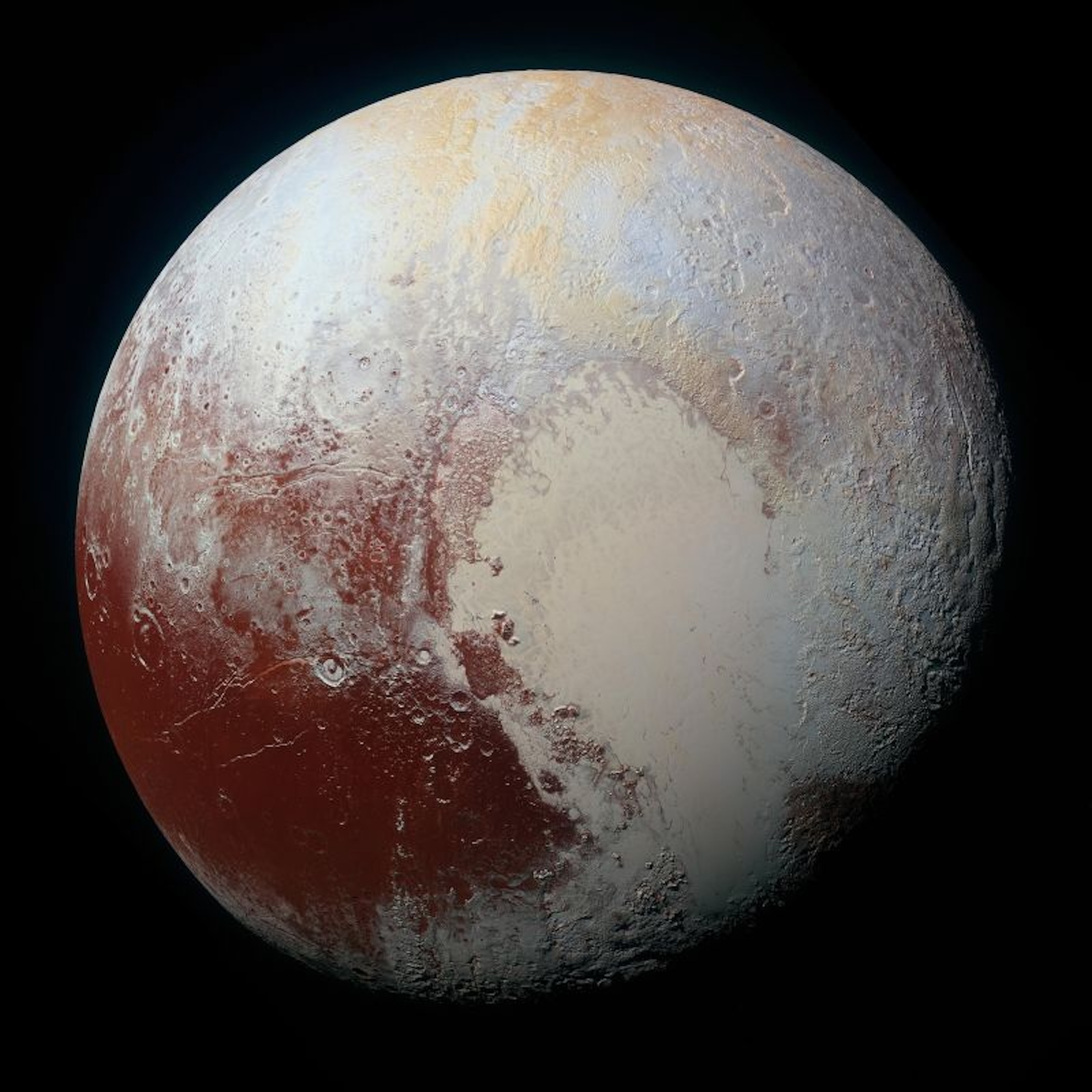(CNN) — A large heart shape on Pluto's surface has fascinated astronomers since NASA's New Horizons spacecraft photographed it in 2015. dwarf planet
The feature is called Tombac Regio after the astronomer Clype Tomba, who discovered Pluto in 1930. But scientists say that the heart is not a complete organ. And for decades, the details of Tombac Regio's height, geology and unique shape, and its brighter white, more reflective surface than the rest of Pluto, defy description.
A deep basin called Sputnik Planitia, which forms the “left lobe” of the heart, contains most of Pluto's nitrogen ice.
The basin covers an area of 1,200 km to 2,000 km, equivalent to a quarter of the United States, but is 3 to 4 km lower in elevation than most of the planet's surface. Meanwhile, the right side of the heart has a layer of nitrogen ice, but it is much thinner.

On July 14, 2015, the New Horizons spacecraft took an image of Pluto's heart. (Credit: Johns Hopkins University Applied Physics Laboratory/Southwest Research Institute/NASA)
Through new research on Sputnik Planitia, an international team of scientists has determined that a cataclysmic event created the heart. After an analysis that included numerical simulations, the researchers concluded that a planetary body with a diameter of 700 kilometers, or twice the size of Switzerland from east to west, may have collided with Pluto early in the planet's history.
The findings are part of a study of Pluto and its internal structure published this Monday In Nature Astronomy Journal.
A recreation of an ancient “splatter” on Pluto
Previously, the team studied unusual features throughout the Solar System, such as those on the far side of the Moon, that may have been created by collisions during the chaotic early days of the system's formation.
The researchers created numerical simulations using soft particle hydrodynamics software, considered the foundation for a wide range of planetary collision studies, to model various scenarios of possible impacts, velocities, angles and compositions of a theoretical planetary collision with Pluto.
The results show that the planetary body probably collided with Pluto at an oblique angle.
“The core of Pluto (the rocky body that collided with the dwarf planet) was very cold because it was very hard and did not melt despite the heat of the impact, and thanks to the impact angle and low speed, the core of the impactor did not sink into Pluto's core, but remained intact as it splashed on top of it,” said the lead author of the study. , a research associate at the University of Bern in Switzerland, said Dr. Harry Ballantine said in a statement.
But what happened to the planetary body after the collision with Pluto?
“Somewhere under Sputnik is the remaining core of another massive body that Pluto never fully digested,” study co-author Eric Asbach, a professor at the University of Arizona's Lunar and Planetary Laboratory, said in a statement.
The team discovered that the teardrop shape of Sputnik Planitia is due to the rigidity of Pluto's core and the relatively low speed of the impact. Other types of faster and more direct impacts would have produced a more symmetrical pattern.
“We're used to thinking of interplanetary collisions as incredibly extreme events where details other than things like energy, momentum and density can be ignored. But in the distant solar system, the speed is much slower and the ice is solid, so you have to be very precise in your calculations,” Asphaug explains. “That's where the fun begins.”
Pluto's dark appearance
While studying the heart aspect, the team also focused on Pluto's internal structure. An impact early in Pluto's history would have created a mass deficit, causing Sputnik Planitia to drift slowly toward the dwarf planet's north pole over time while the planet formed. That's because, according to the laws of physics, the basin is less massive than its surroundings, the researchers explain in the study.
However, Sputnik is close to the equator of the dwarf planet Planitia.
Previous research has suggested that Pluto's surface ocean may exist, and if so, the icy crust in the Sputnik Planitia region would thin, creating a dense bulge of liquid water that would cause mass migration toward the equator, the authors noted.
However, the new study offers a different explanation for the location of this trait.
“In our simulations, Pluto's entire early mantle is dug up by the impact, and as the core material from the impact splashes into Pluto's core, a local excess mass is created that can explain equatorward migration without a surface ocean, or a very thin one,” at the University of Bern's Institute of Physics. Dr. Martin Jutzi, senior researcher for space exploration and planetary science, said.
Kelsey Singer, senior scientist at Southwest Research Institute in Boulder, Colorado, and deputy principal investigator for NASA's New Horizons mission, who was not involved in the study, said the authors thoroughly examined the modeling and their hypotheses. Although he would like to see “a closer connection with geological evidence”.
“For example, the authors suggest that the southern part of Sputnik Planitia is the deepest, but most of the geological evidence means that the south is shallower than the north,” Singer said.
Researchers believe a new theory about Pluto's heart may shed more light on how the mysterious dwarf planet formed. Pluto's origin is obscure because it is at the edge of the solar system and has only been closely studied by the New Horizons mission.
“Pluto is a vast wonderland with unique and fascinating geology, so more creative hypotheses to explain geology are always useful,” says Singer. “What will help us distinguish between the different hypotheses is more information about Pluto's surface. We can only achieve that by sending a spacecraft to orbit Pluto, which can see through the ice with radar.”




:quality(85)/cloudfront-us-east-1.images.arcpublishing.com/infobae/2UOOXCMTEVDUJJ5OO5UCTMBOGM.jpeg)
:quality(85)/cloudfront-us-east-1.images.arcpublishing.com/infobae/ENMAROZTNRTWZF4TEPC67CIGVI.jpg)